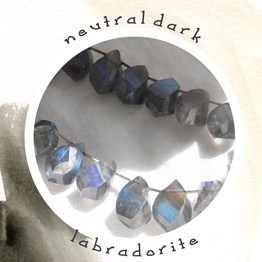n e u t r a l d a r k
Brown and gray
colors result from combinations of other colors: blue, yellow, and small amounts of red create brown, and
red, blue, and small amounts of yellow create gray.
Neutral dark colors here include black, dark brown, dark gray and antiqued metal colors of silver and copper.
Labradorite gemstones tend to be darker gray, and gemstones like onyx, black spinel, jet, and hematite
are exclusively dark colored. Coffee moonstone and smoky quartz are lovely dark brown, and darker woods like walnut and
ebony are also beautiful natural browns.
•• d e s i g n s f e a t u r i n g n e u t r a l d a r k
f u n f a c t s :

Black is the absence of visible light (graphical displays) and a combination of pigment that absorbs
all visible wavelengths. (What looks black to us is the absorption of all wavelengths, with pigments to
absorb all wavebands.) Browns and grays result from mixing complementary
colors; blue and yellow make green, then green mixed with small amounts of red creates brown. The warmth
or coolness of the brown depends on the warmth or coolness of the red. Likewise, mixing red and blue
makes purple, then purple mixed with small amounts of yellow creates gray. The darker hues of these colors
are shown here; lighter hues are listed under neutral light.
Gemstones in this color group include jet, hematite, pyrite, black onyx, labradorite and other silicates containing
iron and/or magnesium (referred to as dark silicates). Limestone and marble may be either light or dark
in color.
Swarovski crystal colors of "mocca", "smoked topaz" and "smoky quartz"
fall in this group, as well as "jet", naturally.
Most darker color pearls are Tahatian pearls or dyed to resemble Tahatian pearls, but some dyed pearls
or glass pearls are dark gray or brown. Dark colored woods like walnut, rosewood, bayong, kamagong, ebony
and boxwood are included here, and lighter woods like maple, beech, cherry and most Asian hardwoods are
found under neutral light.

 Black is the absence of visible light (graphical displays) and a combination of pigment that absorbs
all visible wavelengths. (What looks black to us is the absorption of all wavelengths, with pigments to
absorb all wavebands.) Browns and grays result from mixing complementary
colors; blue and yellow make green, then green mixed with small amounts of red creates brown. The warmth
or coolness of the brown depends on the warmth or coolness of the red. Likewise, mixing red and blue
makes purple, then purple mixed with small amounts of yellow creates gray. The darker hues of these colors
are shown here; lighter hues are listed under neutral light.
Gemstones in this color group include jet, hematite, pyrite, black onyx, labradorite and other silicates containing
iron and/or magnesium (referred to as dark silicates). Limestone and marble may be either light or dark
in color.
Swarovski crystal colors of "mocca", "smoked topaz" and "smoky quartz"
fall in this group, as well as "jet", naturally.
Most darker color pearls are Tahatian pearls or dyed to resemble Tahatian pearls, but some dyed pearls
or glass pearls are dark gray or brown. Dark colored woods like walnut, rosewood, bayong, kamagong, ebony
and boxwood are included here, and lighter woods like maple, beech, cherry and most Asian hardwoods are
found under neutral light.
Black is the absence of visible light (graphical displays) and a combination of pigment that absorbs
all visible wavelengths. (What looks black to us is the absorption of all wavelengths, with pigments to
absorb all wavebands.) Browns and grays result from mixing complementary
colors; blue and yellow make green, then green mixed with small amounts of red creates brown. The warmth
or coolness of the brown depends on the warmth or coolness of the red. Likewise, mixing red and blue
makes purple, then purple mixed with small amounts of yellow creates gray. The darker hues of these colors
are shown here; lighter hues are listed under neutral light.
Gemstones in this color group include jet, hematite, pyrite, black onyx, labradorite and other silicates containing
iron and/or magnesium (referred to as dark silicates). Limestone and marble may be either light or dark
in color.
Swarovski crystal colors of "mocca", "smoked topaz" and "smoky quartz"
fall in this group, as well as "jet", naturally.
Most darker color pearls are Tahatian pearls or dyed to resemble Tahatian pearls, but some dyed pearls
or glass pearls are dark gray or brown. Dark colored woods like walnut, rosewood, bayong, kamagong, ebony
and boxwood are included here, and lighter woods like maple, beech, cherry and most Asian hardwoods are
found under neutral light.